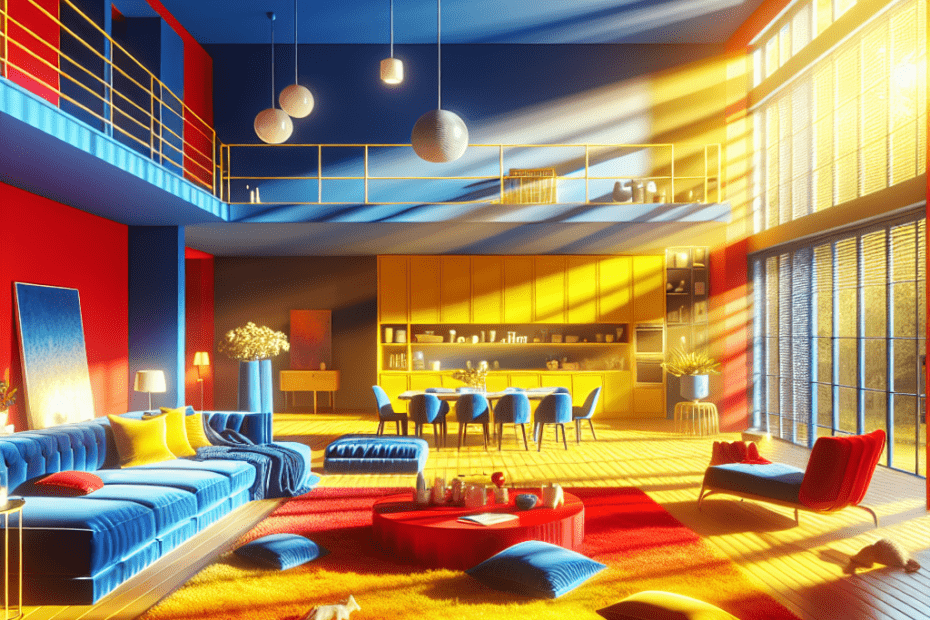“`html
Transforming Spaces: Using Primary Colors for Bold Home Interiors
In today’s ever-evolving world of interior design, many homeowners are seeking ways to express individuality while creating lively environments. They often turn to primary colors in design as a key strategy to achieve such dynamic interiors. Primary colors—red, blue, and yellow—act as the building blocks of the color wheel and can bring an immediate, eye-catching effect to any room.
According to data from the American Society of Interior Designers (ASID), 67% of interior designers have reported a growing trend in the use of bold primary colors to make living spaces more dynamic and engaging. But incorporating these colors successfully requires balance and creativity. This blog post delves into effective ways to integrate primary colors into home interiors, ensuring a bold yet harmonious aesthetic.
Understanding Primary Colors in Design
Primary colors consist of red, blue, and yellow. These three colors serve as the foundation upon which all other colors are built. In design, they are known for their ability to stand out and draw attention, setting the mood of a room with their intensity and vibrancy.
Strategies for Using Primary Colors
When using primary colors in design, the key is to implement them in a way that feels intentional rather than overwhelming. Here are some strategies:
- Accent Walls: One of the most impactful ways to use a primary color is by painting an accent wall. This approach adds depth and contrast without overpowering the entire room.
- Furniture and Accessories: Consider incorporating primary colors through furniture pieces or accessories like cushions, rugs, or artwork. It adds pops of color and personality to the space.
- Color Blocking: Color blocking involves using large blocks of color to create visual interest and dynamism. Using primary colors can make a bold statement when applied thoughtfully in a space.
Balancing Primary Colors for Harmony
To achieve a harmonious look, balance is vital. This often involves the use of neutral colors to tone down the vibrancy of primary colors.
| Primary Color | Complementary Neutral |
|---|---|
| Red | Gray |
| Blue | White |
| Yellow | Beige |
By using complementary neutrals highlighted in the table, designers can ensure the space remains inviting and cohesive.
Primary Colors and Psychological Effects
Beyond aesthetics, primary colors affect mood and energy levels. Red is often associated with energy and passion, blue with tranquility and calm, and yellow with optimism and warmth. Combining these colors can therefore influence the ambiance of a room. For instance, a red accent could energize a study area, while blue might bring tranquility to the bedroom.
Key Takeaways
- Primary colors consist of red, blue, and yellow and serve as the base of the color wheel.
- Successful integration of primary colors involves strategic use through accent walls, furniture, and color blocking.
- Balance primary colors with neutral tones for a cohesive look.
- Primary colors impact mood, with red increasing energy, blue promoting calmness, and yellow fostering warmth.
FAQs
-
Q: What are primary colors?
A: Primary colors are red, blue, and yellow. They are the base colors from which all other colors are derived.
-
Q: How can primary colors affect a room’s atmosphere?
A: Primary colors can affect a room’s mood—red energizes, blue calms, and yellow warms the ambiance.
-
Q: Can primary colors be used in small spaces?
A: Yes, they can be used effectively through accents or small furniture pieces to add vibrancy without overwhelming the space.
-
Q: What is color blocking in interior design?
A: Color blocking involves the use of large blocks of contrasting colors to create a bold, modern look.
-
Q: Are there any risks in using primary colors?
A: The main risk is creating a space that feels cluttered or chaotic. Balance them with neutral tones to avoid this.
“`
